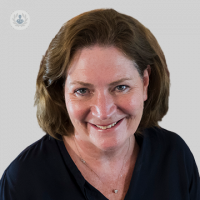What is a benign breast lump?
Written in association with:Benign breast lumps are lumps in the breast that are benign, which means non-cancerous. The lumps are not cancerous, nor are they a precursor to cancer. That being said, no woman should ever assume that a new lump or change in the breast is benign until she has been seen by a specialist and has had the lump assessed. Even if a woman has had previous benign lumps, she should always get new breast lumps checked.
Miss Tena Walters describes what non-cancerous breast lumps feel like and how often women should be screened for breast cancer.

Benign lumps can be solid or cystic. The most common solid lumps are called fibroadenomas. Cysts or cystic lumps are cavities filled with fluid. Any lumps can be seen with mammography and confirmed by ultrasound of the breast and by taking a sample of tissue (biopsy).
What does a benign breast lump feel like?
Benign lumps are usually smooth and mobile within the breast. They are not attached to the surrounding tissue and have a well-defined border. Cysts can be painful. However, none of these features excludes malignancy, as some cancers can feel like benign breast lumps, when in fact they could be cancerous.
How does a benign lump differ from a cancerous lump?
Women should not try to differentiate between benign and malignant lumps on their own. The final diagnosis should always be after a clinical examination, with radiology results and after taking a tissue sample from the lump.
Does a benign breast lump need to be removed?
Benign lumps are not usually removed unless they are causing symptoms, due to their size, for example. Large fibroadenomas that are over 3cm are usually removed.
A large fibroadenoma can be removed with a lumpectomy, whereby the breast tissue is removed and sent to the lab for evaluation. Large cysts can be aspirated with a needle, whereby a thin needle is inserted into the breast and the contents of the breast lump withdrawn.
On occasion, some smaller benign lumps are removed to provide more tissue for a more accurate diagnosis.
Can a benign lump turn malignant?
Benign lumps don't turn malignant, however, any area of the breast tissue can become malignant and this may be close to a known benign lump.
How often should women be screened for breast cancer?
The current NHS National Screening programme recommends screening every three years for women aged 47 to 73. Women with a moderate to strong family history should start yearly screening at the age of 40, 50 or 60 years, depending on the prevalence of breast cancer in their family. Women in Scandinavian countries are screened every two years from the age of 40. If you feel a lump in your breast or notice any changes, it’s always recommended to visit your doctor to rule out cancer or any underlying condition.
If you wish to speak with a Miss Walters about breast lumps, do not hesitate to book a consultation via her Top Doctors profile today.


